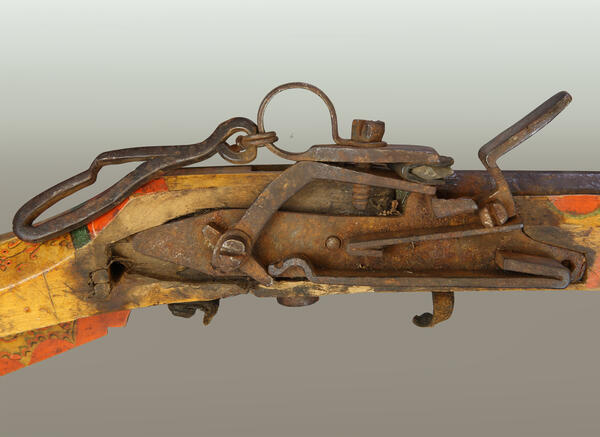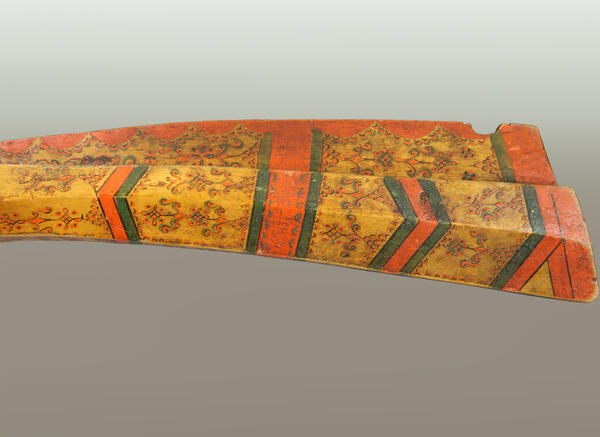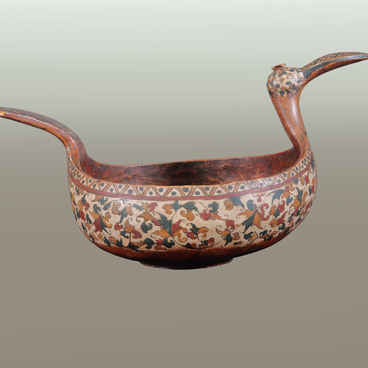In the villages on the Pizhma River, there was a tradition of handwritten books, and many villagers excelled in the art of calligraphy. This skill influenced the miniature patterns used to decorate local art and household items: cups, spoons, rakes, “rubels” (items used in laundry) and others. The most expensive works were obviously guns. Almost all of them had a lengthy inscription, and the stocks were created by the most skillful and experienced artisans. The rifles were purchased at fairs and were highly valued. When the stock wore out, a new one was made for the barrel.
The permanent exhibition of folk art in the Russian Museum presents a skillfully painted flintlock gun made by the artisan and hunter Osip Sergeevich Anshukov. Although the craftsman lived and worked in the village of Skitskaya on the Pizhma River, his guns were known far beyond the village. After all, only Osip Anshukov used a large number of colors in his work: orange, green, pink, red, white, yellow and others. Small patterns and scrolls covering the birch stock were made with a tiny brush and the finest nib. And the artisan was already over 70 years old when he created this gun.
A pattern of numerous brackets, triangles, and circles covers the butt and forearm. Vertical brush strokes divide the surface into sectors, each containing a stylized image of a lily. The old-fashioned way of calling this flower was “blossoming krin”.
Despite the old design, homemade flintlock, and barrel shape, the gun was made relatively recently — in 1915. When making the butts, the artisans of Pechora and Pizhma used the traditional shape of the 17th-century firearms. In the Russian North and Siberia, hunters used such guns for a long time, since the guns produced at state-owned factories were very expensive. Nevertheless, even such an old design was enough to hunt birds, martens, squirrels, and sometimes even bears. Although the gun weighed a lot, it was very accurate and allowed to hit a bird or a squirrel in the head from a distance of 60 steps.
The permanent exhibition of folk art in the Russian Museum presents a skillfully painted flintlock gun made by the artisan and hunter Osip Sergeevich Anshukov. Although the craftsman lived and worked in the village of Skitskaya on the Pizhma River, his guns were known far beyond the village. After all, only Osip Anshukov used a large number of colors in his work: orange, green, pink, red, white, yellow and others. Small patterns and scrolls covering the birch stock were made with a tiny brush and the finest nib. And the artisan was already over 70 years old when he created this gun.
A pattern of numerous brackets, triangles, and circles covers the butt and forearm. Vertical brush strokes divide the surface into sectors, each containing a stylized image of a lily. The old-fashioned way of calling this flower was “blossoming krin”.
Despite the old design, homemade flintlock, and barrel shape, the gun was made relatively recently — in 1915. When making the butts, the artisans of Pechora and Pizhma used the traditional shape of the 17th-century firearms. In the Russian North and Siberia, hunters used such guns for a long time, since the guns produced at state-owned factories were very expensive. Nevertheless, even such an old design was enough to hunt birds, martens, squirrels, and sometimes even bears. Although the gun weighed a lot, it was very accurate and allowed to hit a bird or a squirrel in the head from a distance of 60 steps.





